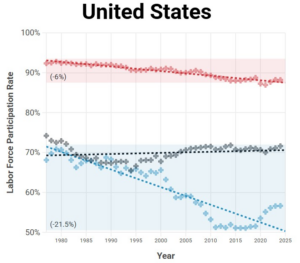Report: Fewer men in Iowa’s workforce could prove costly
Since 2020, 77,000 working-age men have left Iowa's workforce

Gigi Wood Mar 31, 2025 | 12:18 pm
6 min read time
1,363 wordsAll Latest News, Economic Development, Uncategorized
Iowa’s pool of male workers declined sharply in recent years, and the trend could be costing the state’s economy billions of dollars, according to a new report.
The Common Sense Institute on March 26 published its latest report, “Where are the Men?,” which shows 77,000 working-age men in Iowa have left the workplace since 2020.
The departure of so many men from the state’s workforce equates to a loss of $10 billion in gross domestic product and $4 billion in personal income, the report states.
The nonpartisan institute was founded in 2010 in Denver, Colo., by a group of business and community leaders. It expanded to Iowa in 2023.
National shift
The reduction in workforce is happening across the country. Nationally, millions of people have left the workforce since the pandemic began in 2020. The labor force participation rate now is 62.4%, down from 63.3% in February 2020 and 67.2% in January 2001, according to the U.S. Bureau of Labor Statistics.

The national labor force participation rate of men in various years, according to Federal Reserve Economic Data:
- 1950: 86.2%
- 1975: 78.1%
- 1990: 76.3%
- 1996: 74.6%
- 2000: 75.1%
- 2009: 72.4%
- 2015: 69.3%
- 2020: 63.3%
- 2025: 62.4%
Iowa’s labor force
The CSI study showed Iowa traditionally had high labor force participation, ranking ninth-highest in the country at 67%, and had the 13th-lowest unemployment rate at 3.3%.
“However, while Iowa enjoys stronger topline employment and labor force numbers than the U.S., it shares the same trends in male workforce participation rates among the three major age groups,” the report stated.
Based on available data, Iowa’s overall labor force participation rate, including men and women of all ages, peaked in 1996 at 73.3%, according to the Federal Reserve. In 2020, Iowa’s labor force participation rate was 69.1%. In January and February 2025, the rate was 67%, according to Iowa Workforce Development.
In Iowa today, there are 67 workers to fill every 100 jobs. There are states with a more severe labor shortage, such as North Dakota, which has 30 available workers for every 100 open jobs. On the other end of the spectrum, Texas has 80 workers for every 100 open jobs.
In Iowa, the number of men ages 25-54 not working and not seeking work has increased steadily during the past 60 years. Iowa’s male workforce has decreased by:
- 18.7 percentage points since World War II
- 6.5 percentage points since 1977
- 3 percentage points since 2000
“The long-term decline in labor force participation among Iowa’s prime-working-age men is one of the most significant, yet underrecognized, economic challenges facing our state,” Ben Murrey, director of policy and research at CSI, said in a news release. “The data show educational attainment, family structure, and industry shifts are all contributing to this trend. Re-engaging these men in the workforce could yield nearly $10 billion in additional GDP annually — a clear signal that restoring participation isn’t just a social imperative, it’s an economic necessity.”
In an interview, Murrey said if the labor supply is constricted, it pushes the price of labor up, increasing the cost of goods and services. If businesses cannot pay that higher price of labor, people move to other states.
“If businesses can’t compete, then people flee,” he said.
The report suggests policymakers and business leaders work together to reengage men in the workforce. Otherwise, Iowa should be prepared for the “long-term consequences of a shrinking labor force,” the report stated.
Correlations
While the report did not determine a cause of the decline in male workers, it found six key data points related to the downward turn. Keep in mind that correlation does not equal causation, Murrey said. Those six data points are:
- College attainment, which is linked to higher rates of labor force participation. Iowa men ages 25 to 54 with less than an associate degree are 39% less likely to participate in the labor force compared with those with higher education attainment. Meanwhile, young, college-educated Iowans are leaving the state faster than any other demographic.
- Marital status, which shows marriage declining among men. From 1977 to 2024, the share of Iowa men who were married declined from 83.6% to 58.9%. The average never-married man in Iowa is 51% less likely to be in the labor force than a married man. Research has found married men tend to secure higher-paying jobs and are more likely to be promoted than their single counterparts, the study said. Divorce also often leads to a change in living arrangements, with many men moving back in with their parents.
- Living arrangements, which affect labor force participation. Iowa men between the ages of 25 and 54 who live at a relative’s or non-relative’s home are 60% less likely to be in the labor force than those who claim to be heads of households. The combination of low savings, job insecurity and free housing may make young Americans less inclined to remain in the workforce than those living on their own, the report said. The study ties living with family to an increase in video-game playing. The study said that the percentage of U.S. males between 25 and 54 who play video games on an average day has tripled, rising from about 4% in 2003 to over 14% in 2023. “Policymakers have two potential paths to address the lower [labor force participation rate] among Iowans living with relatives: economic relief and cultural influence. On the economic front, easing the burden of housing and basic living expenses could help. One approach is to incentivize and reduce barriers to new home construction, increasing supply and potentially lowering costs,” the study stated.
- Disability rates, which are increasing among men. The average Iowa male between 25 and 54 claiming any difficulty related to disabilities is 94% less likely to be in the labor force than a male with no difficulties. According to the study, the percentage of disabled men between 18 and 34 grew 2.87% from 2010 to 2023. Of that growth, 68% occurred after 2019, the study said.
- Deindustrialization, or the decline in manufacturing jobs. Manufacturing, which employs 20% of Iowa men in the workforce, has seen high initial unemployment claims. In the past couple of years, Iowa has seen several manufacturers either lay off workers (John Deere and Kinze Manufacturing) or close (JELD-WEN). Economic uncertainty coupled with repeated cycles of unemployment may discourage men from reentering the labor force, leading to a decrease in male labor force participation, the report said.
- Crime rates, which affect participation in the labor force. In 2023, males between 16 and 40 made up 32.8% of Iowa’s total population but were responsible for 46.4% of all criminal offenses.
Economist Nicholas Eberstadt, who holds the Henry Wendt Chair in Political Economy at the American Enterprise Institute, for years has studied the issue of the decline of men in the workforce, according to Common Sense Institute’s report.
In his book, “Men Without Work: America’s Invisible Crisis,” Eberstadt writes that “increased leisure time, reliance on disability benefits, support from relatives, the decline in marriages, church attendance, and community involvement, among other unnamed factors, have incentivized an ongoing withdrawal of prime-age men from the workforce.”
This trend of fewer men in the workforce also surfaced last week when the Iowa Business Council released its annual Competitive Dashboard report.
“Available workforce continues to be a significant concern for the Iowa Business Council,” said Gage Kent, chairman and CEO of Muscatine-based Kent Corp., and chair of the IBC.
A 2024 Pew Research Center study also outlined labor market trends illustrating the drop-off in male labor force engagement.

Gigi Wood
Gigi Wood is a senior staff writer at Business Record. She covers economic development, government policy and law, agriculture, energy, and manufacturing.









